Translate this page into:
Comparison of expander and Instant Controlled Pressure-Drop DIC technologies as thermomechanical pretreatments in enhancing solvent extraction of vegetal soybean oil
⁎Corresponding authors at: La Rochelle University, LaSIE (Laboratory of Engineering Sciences for Environment), 7356 UMR CNRS, Avenue Michel Crépeau, 17042 La Rochelle, France (C. Jablaoui and K. Allaf). kallaf@univ-lr.fr (Cherif Jablaoui)
-
Received: ,
Accepted: ,
This article was originally published by Elsevier and was migrated to Scientific Scholar after the change of Publisher.
Peer review under responsibility of King Saud University.
Abstract
As an intensification process of the unit operation of vegetable oil extraction, the cooking pre-treatment systematically results in damaging thermal degradations. However, recently, two thermomechanical expansion processes have been suggested and applied at industrial scales to pre-treat oilseeds: expansion and instant controlled pressure drop DIC. In both cases, it is a flash transformation from high-temperature/high-pressure to 100 °C/atmospheric pressure and 33 °C/vacuum phases, respectively. The use of DIC resulted in cumulative impact yields of 247 mg oil/g db, compared to 210, 230, and 224 for cracking, cracking/blocking, and expanding, respectively. To achieve the same yields obtained in 160 min for cracked or cracked/flaked soybean, the expander took 120 min against 35 min for DIC. Besides, thanks to the short heat treatment and the induced instant cooling, DIC allowed the highest preservation of soybean oil quality, with fatty acid concentrations almost identical to that of untreated seeds.
Practical impacts
In the sector of the vegetal oil industry, researchers and engineers mostly look for increasing the extraction yields while preserving or improving the sensorial and biochemical quality of the oil. Henceforth, the modification of the oleaginous seed texture may usually be the major factor affecting and normally enhancing the capacity of extraction. Based on the improvement of material structure through adequate expansion, the higher the volume of vapor issued from the autovaporization throughout the instant controlled pressure-drop (DIC) technology, the higher the oil yields. Moreover, using the instantaneous thermodynamic theory, the feasibility of integrating DIC technology as an HTST treatment in the industrial-scale soybean extraction process could be performed and optimized without any biochemical degradation.
Keywords
Texturing
Instant Controlled Pressure-Drop (DIC)
Coupled washing-diffusion modeling
Effective solvent diffusion
Oil quality preservation
Nomenclature
- a
-
Percentage of dry matter in soybean
- C
-
Soybean cracking (C)
- CCD
-
Central composite design of experiments
- CF
-
Soybean cracking-flaking (CF)
- CFEx
-
Soybean cracking-flaking-expanding (CFEx)
- cp,d
-
Specific heat capacity of dry matter (cp,d = 1050 J kg−1K−1)
- cp,o
-
Specific heat capacity of soybean oil (cp,o = 2385 J kg−1K−1)
- cp,w
-
Specific heat capacity of water (cp,w = 4180 J kg−1K−1)
- CPA
-
Central Point Average
- CWD
-
Coupled Washing/Diffusion phenomenological kinetic modeling where washing is the interaction between the solvent and surface
- Deff
-
Effective solvent diffusivity (m2s−1)
- DIC
-
Instant Controlled Pressure-Drop
- DM
-
Dynamic Maceration
- DoE
-
Design of Experiments
- ΔTpd
-
Variation of temperature through the pressure drop for Expander or DIC texturing processes
- δYs
-
Value of starting accessibility expressed en (kg oil/kg dry basis db)
- GC
-
Gas chromatography
- HPLC
-
High performance liquid chromatography
- HTST
-
High-Temperature/Short-Time
- L
-
Latent heat of vaporization at Tt (J kg−1)
- md
-
Amount of dry matter (kg)
- mv
-
Amount of vapor generated by autovaporization (kg) through the pressure drop for Expander or DIC texturing processes
- NER
-
Negligible External Resistance hypothesis for phenomenological modelling
- P
-
Saturated dry steam pressure (MPa) in DIC treatment
- PTFE
-
Polytetrafluoroethylene membrane Filters
- Qc
-
Amount of cooling energy for Expander or DIC texturing processes
- Qh
-
Amount of heating energy for Expander or DIC texturing processes
- qi2τ
-
= for infinite plate and = for spherical form
- Qt
-
The total amount of energy used with Expander or DIC texturing processes
- RM
-
Raw Material
- RSM
-
Response surface methodology
- t
-
DIC treatment time (s)
- T
-
Temperature (°C)
- Ta
-
Ambient temperature
- Tc
-
Post cooling temperature after Expander or DIC texturing processes
- Tf
-
Final Equilibrium temperature of Expander (100 kPa) or DIC texturing process (5 kPa)
- TRY
-
The time required to reach the same cracked beans C as the reference Yield (min)
- Tt
-
Treatment temperature just before dropping the saturated steam pressure (°C)
- Wp,H2O
-
Moisture content dry basis (kg H2O/kg db)
- Xwb
-
Percentage of Moisture content in soybean
- Y∞
-
Oil yield at infinite time
- Y(t)
-
Oil yields versus extraction time
- Y0
-
The calculated value of oil yield at t = 0
- Yi
-
Value of oil yield at t = 0; here = 0
- Yo
-
Percentage of oil in soybean
- Yoil
-
Oil yield = Extract Oil Mass/Dry Basis (db) Mass (kg Oil/kg db)
- Yt0
-
Oil yield at a time t0
1 Introduction
Engineers and researchers studying the processes of extraction of plant-based ingredients (active molecules, fibers, vegetable oils, proteins, etc.) agree in the necessity of changing the natural structure of the plant before performing the properly said solvent extraction. Extraction process from beans and seeds, fruit and vegetables, leaves and roots, etc. normally requires significant initial pretreatment operations, such as husking and cutting, crunching and grinding, cracking and flaking, etc. Furthermore, the operations capable of increasing the porosity and tortuosity, allow improving the technological ability for solvent extraction.
The extraction of vegetal oil is highly important in industrial processes. Likewise, for dozens of years, soybean has become one of the strongest oleaginous seeds with significant amounts of both oil and protein with 21.38% and 40.69% db (dry basis), respectively (Brumm et al., 2004). Thus, soybean has become one of the most important food crops and the main lipid resource consumed in the United States (57%) which, according to Cheng et al. (2018), is the world's largest producer. The soybean oil is the largest vegetable oil used in industrial food applications such as cooking, frying, etc., reaching 75% of the total human consumption of oil. With about 54% of the worldwide vegetal oil production, soybean is currently the main source of vegetable oil (USDA, 2020) and protein-based meals (Britz et al., 2008). The adequate chromatography analyses show that the polyunsaturated fatty acid fraction was the dominant compound with a combination of linoleic acid C18:2, oleic acid C18:1, and linolenic acid C18:3 (Omega 3) with percentages of 47.6%, 27.15%, and 6.7%, respectively (Cheng et al., 2018).
Commonly, the extraction of soybean oil is carried out by solvent, mainly n-hexane, which has been preferred because of its high selectivity in dissolving the oil, its high volatility in removing it from the meal, its high productivity and weak energy consumption, and environmental effects (Hammond et al., 2005); (Rosenthal et al., 1996), and relatively low cost.
However, it is worth noticing that the modern industries of solvent extraction of oil, some initial pre-treatment operations of oleaginous seeds have been used to render the structure and the sizes more adapted to the process, whilst avoiding preheating stages that would induce thermal degradations (Perez et al., 2011). Hence, normally successive mechanical pretreatments are used such as i/ dehulling, ii/ grinding, and iii/ flattening. More recently, the use of expander has been developed. It consists of short-term heat treatment at high steam pressure, followed by rapid depressurization towards the atmospheric pressure. Expander treatment requires also a subsequent cooling step to reach the ambient temperature level to stop thermal degradation and meet consumer requirements of high-quality oil and meal. Expander removes the outer membrane, reduces the surface resistance to mass transfer, and increases the porosity of the bean matrix. Specifically, the solvent gets higher diffusivity within the expander-texture grain. Therefore, a significant change in the structure of oleaginous material is essential to achieve porosity (Zhang et al., 1994) (Hernandez E, 2019).
Nowadays, the pretreatment of seeds before the hexane extraction process and the degumming and other refining operations are included in the industrial flow diagram Fig. 1.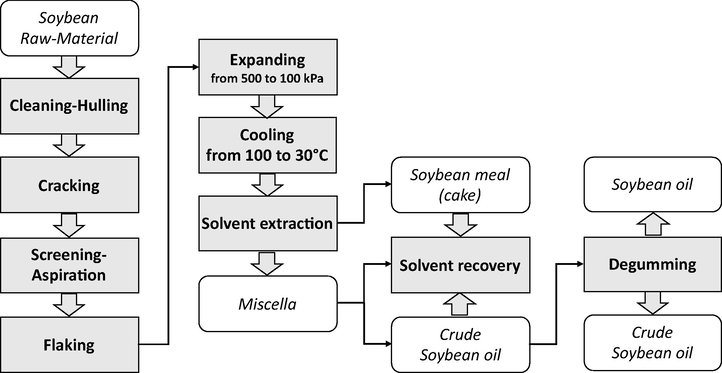
Industrial flow-chart of the solvent extraction of soybean oil.
The dehulling process of removing the outer membrane allows more direct contact between the solvent and the interaction bean surface. The cracking operation results in the breaking up into small pieces of soybeans, which pass between two crenelated cylinders able to achieve the distortion and breakage of the grain. Although such an operation implies no real modifications of the diffusivity, the extraction is improved through the reduction of the transfer distance and the increase of the interaction surface. Thus, grinding normally results in increasing the interaction between the granules and the solvent. Thus, the crushing stage is generally followed by an aspiration operation performed to purge the fine powder and eliminate the shell-forming about 8% of the weight of the seed. This operation allows a clear increase in protein in the cake. Following cracking, the flaking of the soybeans is carried out using a passage in a succession of rotating cylinders operating at high temperatures. The thickness of the flasks obtained ranges from 0.2 to 0.3 mm, which results in a greater interaction surface area between the solvent and the material, i.e. a greater starting accessibility. However, it is worth noticing that such pressing usually implies a decrease in porosity and thus a lower diffusivity. Notwithstanding, chipping generally has a positive impact on extraction with better yield and greater kinetics (Zhang et al., 1994).
The study of extrusion and expander in the preparation of oleaginous materials started in the 1970s at a laboratory scale. Contrariwise, their use at the industrial-scale has not started before the 1980s to impact oil extraction (Johnson and Lusas, 1983). The expander allows the soybeans to be in close contact with a high-pressure saturated steam flow and move through a screw within the high-temperature treatment vessel. This heating system converts soya flakes into porous plugs employing the rapid passage of the material from the high-pressure zone (in the internal part of the expander) towards the atmospheric pressure. Extrusion and expander mainly differ from the heating energy source. Indeed, while the expander heats the seeds by condensation/convection of saturated and super-heated steam, the extrusion heating source is chiefly performed by the mechanical way of sharing between the screw and vessel-wall (Mat Yusoff et al., 2015). Allaf et al. (2014) proved that the decompression towards the atmospheric pressure systematically has a very limited impact in terms of expansion, whereas the instant controlled pressure-drop towards a vacuum has a much higher capacity of texturing (swelling, etc.). DIC can lead to a rupture of the cell walls. Indeed, the texturing effect normally depends on the amount of vapor generated by autovaporization which is directly correlated with the temperature drop ΔTpd. Thus, at a similar temperature and for different treatment-time, expander impact should normally be much weaker than the Instant Controlled Pressure-Drop DIC. Hence, expander treatment of oleaginous grains, which is usually performed at 0.6 MPa as absolute steam pressure with about 160 °C as treatment temperature, the decompression towards the atmospheric pressure results in a temperature drop ΔTpd = 60 °C. With similar treatment conditions of steam pressure and temperature, DIC flash-depressurization usually achieved around a vacuum of 4 kPa, i.e. a final equilibrium temperature of about 30 °C, has a twice more temperature drop ΔTpd = 130 °C.
Our present study deals with inspecting, defining, and evaluating the impacts the different mechanical pretreatments and thermal/mechanical texturing ways on solvent extraction of soybeans brought in terms of oil yields and quality. It aimed at relevantly measuring the effects of the processing conditions and optimizing the specific case of Instant Controlled Pressure-Drop DIC texturing for the most relevant industrial operation. Such a study should also allow establishing empirical correlations between treatment conditions, structure, and functional behavior of differently pretreated soybeans. More than a simple yield intensification and preservation of both oil and meal quality, this study goes beyond the simple technical comparison study of the texturing treatment. It was integrating the industrial processes and identifying their impacts in terms of energy consumption, environmental impact, and total costs.
2 Materials and methods
2.1 Raw materials
American soybeans were provided by “Carthage Grains” corporation. They were pretreated at an industrial scale before achieving the solvent extraction operation. The sequential pretreatments were the cracking (C), cracking-flaking (CF), and cracking-flaking-expanding (CFEx) (Fig. 2). Afterward, these differently pretreated C, CF, and CFEx soybeans were textured by Instant Controlled Pressure-Drop DIC using the laboratory-scale equipment at different conditions of saturated dry steam pressure P and treatment time t, as defined by the Design of Experiments (DoE). The differently pretreated soybeans were all adjusted in terms of moisture content using an airflow drying at 40 °C and 3 m/s to reach 11% wet basis.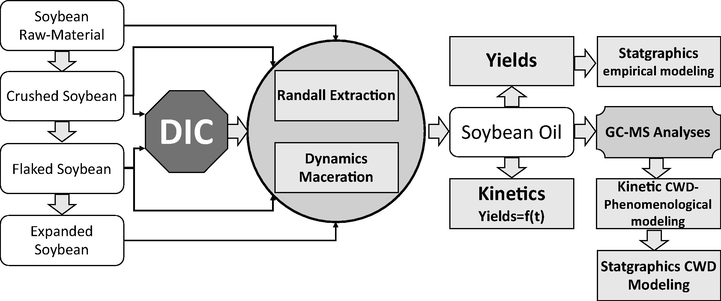
Diagram and experimental protocol of soybean oil extraction inserting a DIC texturing stage.
2.2 Chemical product
For the extraction and analysis of soybean oils (fatty acids and tocopherols), the solvents used (methanol, ethanol, toluene, dichloromethane, acetonitrile, chloroform, and hexane) were HPLC and GC -grade solvents were supplied from Thermo Fisher Scientific (Courtaboeuf, France) by UniLasalle Polytechnic Institute (Beauvais, France) and La Rochelle University (France).
2.3 Experimental methodology
N-hexane solvent extraction of soybean oil was accomplished with differently pretreated samples C; CF; and CFEx. To recognize the best manner of Instant Controlled Pressure-Drop DIC texturing, we defined a specific Design of Experiment DoE integrating the main DIC operating parameters. The responses in terms of yields and kinetics were measured as the most effective way to assess the modification of the technological aptitude of the materials. Randall extraction method was adapted to compare various yields while dynamic maceration allowed defining the extraction kinetics. Additionally, chromatography analyses were used for measuring the concentration of different fatty acids and specifying the extracted oil quality.
The protocol based on the integration of DIC texturing in the preparation stage of the soybean seeds before solvent extraction.
Fig. 2 presents different routes for vegetal oil extraction including the possible ways to improve yields and kinetics of soybean oil extraction by adding DIC treatments using a Design of Experiment DoE on each type of pretreated seed at the industrial scale of the solvent extraction line.
2.4 Main intensification ways and technology
DIC texturing process (Fig. 3) had different impacts depending on the operating parameters, the characteristics of soybeans. It changed the porosity and the tortuosity of the treated samples to, consequently, increase the solvent diffusivity within the bean. It also allowed breaking the cell walls and increasing the oil availability in the grain (Jablaoui, 2018). The modifications of oil diffusivity and availability allowed n-hexane extraction to revise Randall yields and dynamic maceration kinetics, respectively.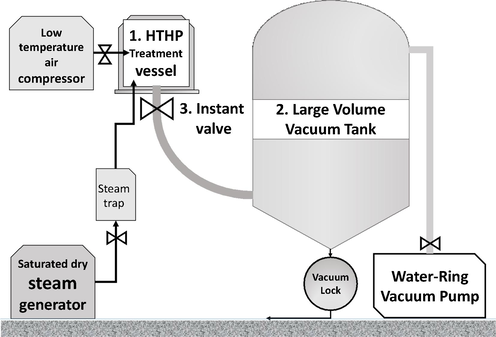
Schematic diagram of DIC laboratory scale unit: 1/ Treatment vessel; 2/ Vacuum tank; 3/ Large section-instant opening valve; 4/ water-ring vacuum pump; 5/ Saturated steam generator with condensed water trap.
Fig. 4 shows that the difference in temperature just before and after DIC flash decompression mainly alters its impacts. By using the saturated dry steam as the heating source, the treatment temperature ranged from 152 to 180 °C depending on the pressure range between 0.5 and 1 MPa. DIC processing time t usually ranged between 10 and 100 s, was defined to ensure adequate thermal and moisture homogeneities within the seed. The pressure-drop is performed towards a vacuum of 4 kPa, with an instantaneous mode in less than 20/40 10−3 s. Usually, the decompression rate ΔP/Δt should be higher than 500 kPa s−1.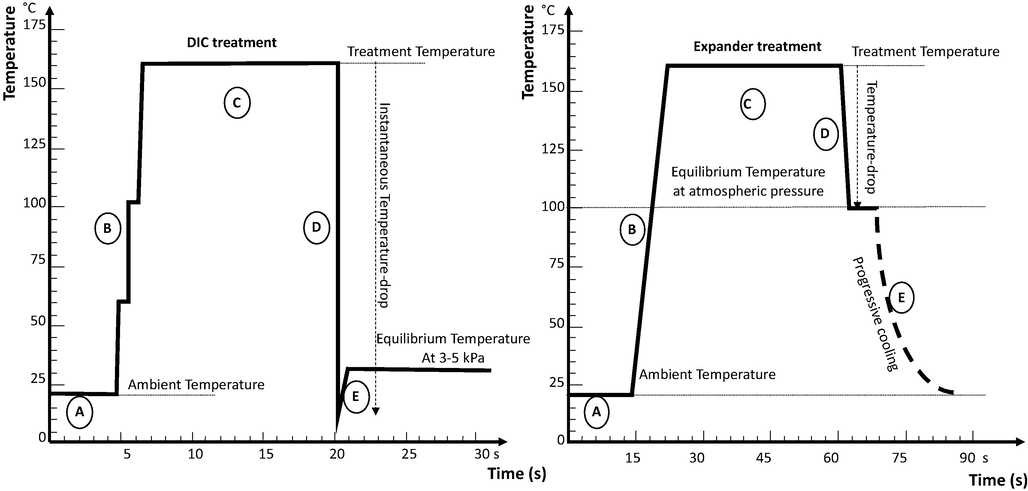
Stages of DIC and expander treatments, respectively: A/ Grains to set in the treatment vessel to immediately connect with the vacuum tank (only for DIC); B/ Saturated dry steam to inject till reaching the desired pressure and temperature treatment levels; C/ High pressure/high temperature to maintain for dozens of seconds (for DIC) and some minutes (for expander); D/ Pressure to abruptly drop towards a vacuum (3–5 kPa for DIC), and towards the atmospheric pressure (for expander); E/release from the vacuum towards the atmosphere pressure (for DIC) and a cooling stage from 100 °C towards an almost ambient temperature (for expander).
Fig. 4 shows the DIC stage. It is worth noticing that a first vacuum phase is achieved to set a close superficial interaction between the material and the saturated dry steam in the treatment vessel. The high-temperature/high-pressure stage is usually defined to allow the grain to reach suitable internal thermal and moisture homogeneities. By abruptly dropping the pressure towards a vacuum, the autovaporization of some amount of the grain water instantaneously happens, provoking an inevitable cooling and a possible texturing.
The structure modification of the grains in terms of expansion ratio and tortuosity inevitably depends on the quantity of the generated vapor mv and more specifically its volume. For similar treatment parameters of saturated steam pressure and temperature Tt, the autovaporized quantity of mv strictly depends on the final pressure, and, obviously the final temperature Tf. Since the vacuum level of DIC was about 4–5 kPa, the temperature abruptly reached just after the instant decompression an equilibrium level of about 30–33 °C. This means that mv was about twice more in DIC with than in expander . It is well-known that the higher the amount of vapor generated by autovaporization, the higher the texturing effect (Ben Amor and Allaf, 2009).
Subsequently, by instantaneously dropping the saturated dry steam towards a vacuum, DIC incites a much higher possible expansion leading to much better porosity and greater tortuosity than expander can do. The optimized DIC treatment should inexorably imply higher texturing and tortuosity, hence possibly increasing the technological aptitudes of the product in terms of effective diffusivity and starting accessibility with a higher interaction exchange surface. Likewise, the autovaporization/texturing process may also lead to breaking cell walls, which increases the availability of the oil and active molecules in the cells (Allaf and Allaf, 2014) and (Jablaoui et al., 2019).
During the outstandingly short-time pressure-drop (dozens of milliseconds), only the thermodynamics of instantaneity can adequately interpret this far-from the quasi-static process. Since the temperature is fundamentally defined as the density per mole of the kinetic energy of anisotropic translational random micro-agitation, the one-dimension organization of velocity during such so short time decompression results in a precipitous cooling, easily crossing the glass transition and greatly improving the vapor separation (Chemat et al., 2017).
2.4.1 Oil yield and solvent extraction of soybean seeds
The impact of DIC treatments at different operating parameters was assessed by measuring the oil yields and kinetics through n-hexane extraction. Each treated sample was crushed using a knife-grinder for 15 s at 10000 t/min. Particles of 0.4 mm in diameter were selected for determining the oil yield based on Eq. (2) (ISO 659:1998 - Oilseeds; Determination of oil content).
2.4.2 Solvent extraction through Randall method
Similarly, the differently DIC-treated soybeans were crushed. 3 g of soybean powder at 11% moisture were placed in a Randall velp-148 using n-hexane at 55 °C, for 6-h. Then, the extract was evaporated under vacuum using a 6-L rotary evaporator (Genser Scientific Instruments 91,541 Rothenburg ob der Tauber; Germany) at 40 °C until constant mass to recover hexane Micelle and residue under a dry air stream (Ben-Youssef et al., 2017).
2.4.3 Dynamic Maceration (DM)
3 g powder of DIC treated soybeans and a volume of 40 ml of n-hexane were added to a 100-ml Erlenmeyer flask of. The mixture was stirred at 200 rpm for 12 h at 55 °C (slightly lower than the boiling temperature of hexane). To study the maceration kinetics, the samples were collected at different extraction times and filtered through a 0.2 μm filter syringe of (PTFE filters). The extracted oil was separated from the solvent, and, then quantified. The filtrates were evaporated to a constant weight under nitrogen flow at ambient temperature. The extraction yield was defined as the amount of the oil extracted from 100 g of matter. Each experimental run was conducted at least in duplicate.
2.5 Study and modeling of the extraction kinetics
After the starting stage of superficial interaction of the solvent, and since n-hexane is capable of greatly dissolving the vegetable oils, the two phenomena of solvent–solute diffusion within the grain, and mass convection at the exchange surface, simultaneously occur. Since the extraction process was made under high-speed stirring conditions, the external superficial transport was so intensified that the extraction process briefly became Negligible External Resistance (NER). The internal effective diffusion of the solvent–solute was the limiting process.
Thus, the solvent extraction kinetics was studied through the phenomenological model of Coupled Washing/Diffusion (CWD). In these conditions, the internal mass transfer revealed the whole extraction process. Subsequently, it was modeled based on similar Fick's law with the effective diffusivity Deff (m2 s−1) to expose the global internal liquid transfer (Fernández et al., 2012). The mathematical solutions change depending on the specific conditions of the shape and average size of the granules. In the present case, we assumed Deff as a constant, independently on the position within the grain and operation time. Crank solutions can then be adopted as series or error functions for short diffusion times, or trigonometric series or Bessel functions for larger time (Lebovka et al., 2016).
By limiting Crank series to its first term, the logarithm transformation allows linearizing Eq. (3), to identify the slope K. The experimental results to use must excluding the data ranged between the initial time (t = 0) and t0 assumed as a time that let the extraction be controlled by the diffusion. Thus, the effective diffusivity Deff is estimated from Eq. (4):
It is noteworthy that only the experimental results for t > to were used in pursuing Deff. By extrapolating this theoretical model towards the origin (t = 0), an initial yield
usually higher than Yi = 0 should reveal the starting accessibility
yield (g oil/g db):
The difference between the initial value of yield (Yi = 0) and the theoretical value calculated from the diffusion model divulges the starting accessibility to link with the initial superficial interaction (Bouallegue et al., 2019). The starting accessibility δYs unfolds the oil quantity issued from the interaction between the solvent and the interaction surface of the product, normally carried out over a very short time.
2.6 Assessments and characteristics
2.6.1 Chromatography measurements
Gas Chromatography GC was used to identify and quantify the free fatty acids. GC was Agile Gas Chromatography 19091S-433 (Kyoto, Japan) well-appointed with a specific column (HP-5MS 30 m*350 µm*0.25 µm). The oven followed a special temperature program starting at 155 °C to rise 230 °C in 2 min to keep at a constant level of 240 °C for 50 min. Helium was the carrying gas used at 0.37 m/s as speed.
In an adapted vial, we set a sample of 15 µl of oil, added 20 µl of Tolbutamide Methyl-Hydroxylase (TMH) with 1 ml of solution (50/50) of methanol-chloroform. Successively, samples of 1 µl each were automatically injected in a split mode of 1/200. The system was set to identify the fatty acids and their concentrations were measured through the integration of the peaks using an internal program library (de Carvalho Claudio Guilherme Portela et al., 2018).
High-Performance Liquid Chromatography HPLC we used for the quantification of tocopherols was a Shimadzu system fitted with two (LC-10AD) distribution pumps, an FL/FR-10AXL detector, an automatic injector of 25 µl per sample, and, finally, an Altimma RPC-18 separation column of 250 × 4.6 mm × 5 µm (Associates Inc.). Acetonitrile/methanol solution of 75:25 was injected as the mobile phase at 1 ml/mm as a flow rate. We stabilized the temperature of the column at 250 °C, set the fluorescence detector at 298 nm and 344 nm for excitation and emission wave, respectively, and selected the total separation time at 40 min. The α, β, and γ tocopherol fractions were identified, and their concentrations were measured based on the retention time set with a calibration range of the different standards.
2.6.2 Scanning electron microscopy
The assessments of microstructural changes of each soybean material depending on its pretreatment way were achieved through an environmental scanning electron microscopy (SEM) (JSM—5410/5410 LV JEOL Ltd., Tokyo, Japan), using the method defined by Mounir et al. (2015). Each type of soybean was positioned using carbon adhesive on covered support and the measurements were performed under a vacuum of 7 Pa and an accelerating voltage of 20 kV.
2.6.3 Design of experiment DoE
Among various possibilities, we opted for the Box Behnken as Design of Experimental DoE to study the effect of DIC process parameters of saturated dry steam pressure (P) and treatment time (t) on the oil extraction yields and kinetics. The RSM (response surface methodology) was chosen as a nearly rotatable second-order design, with a five-level complete design consisting of the center point, and the factorial and star points, normally identified as the points of the edges from a cube. Indeed, while our objective was to study and optimize the DIC conditions, a 5-level central composite design (CCD) was the most adequate design of experiment (DoE). This implies a second-order empirical regression model to set the relationship between the controlled independent variables of P and t input and the chosen responses. The selection of the independent variables of the DIC processing parameters and their variation ranges was based on the data issued from the literature and the accumulated 30-year know-how of our research team. Additionally, some preliminary experiments were carried out in this objective. The dependent variables chosen as responses were the following: oil yield , time to reach the same yields as cracked Cr soybeans do in 160 min, starting accessibility δYs, and effective diffusivity Deff.
To set the response surface methodology (RSM) to perform the statistical study of the data issued from our experiments, Statgraphic software has been able to define the Analyses Of Variance (ANOVA) and p-value of 5% probability level (p < 0.05), and display on Pareto charts to highlight the impacts of independent variables on each response. We reviewed the fit-degree of the model to quote the lack of correspondence, including Fisher-test value and p-value, and also built up the response surface from a quadratic empirical equation, while defining R2.
3 Results and discussion
3.1 Yield extraction versus DIC processing parameters
The samples of different mechanically pretreated cracked (C), flaked (CF), and expanded (CFEx) soybeans, as well as the respective DIC textured forms (C-DIC) and (CF-DIC) were all submitted to the solvent extraction at the same conditions (Randall velp-148 using n-hexane at 55 °C, for 6-h). The values of oil yields expressed in (g oil/g db) were shown in Table 1. P: DIC saturated dry steam pressure (MPa); t: DIC processing time (s); Yoil: n-hexane Oil yields (g oil/g db: dry basis); RIE (Ratio of Improvement of oil Extraction) = Yoil-DIC/Yoil-RM (%); CPA: Central Points (DIC1, 4, 7, 10, and 13).
DIC parameters
Cracked C seeds
Flaked CF seeds
Expanded CFE seeds
P (MPa)
t (s)
Yield in g oil/g db (RIE %)
Untreated samples:
0.20962 (100.00%)
0.23019 (100.00%)
0.2352 (100%)
DIC-CPA
0.45
70
0.2300 ± 0.0020 (109.71 ± 0.95%)
0.2439 ± 0.0006 (105.95 ± 0.25%)
–
DIC2
0.7
70
0.21597 (103.03%)
0.23352 (101.45%)
–
DIC3
0.45
120
0.24215 (115.52%)
0.24216 (105.20%)
–
DIC5
0.63
105
0.23145 (110.42%)
0.24713 (107.36%)
–
DIC6
0.63
35
0.22590 (107.77%)
0.23539 (102.26%)
–
DIC8
0.27
35
0.22839 (108.95%)
0.23559 (102.35%)
–
DIC9
0.27
105
0.22114 (105.49%)
0.23839 (103.56%)
–
DIC11
0.20
70
0.21719 (103.61%)
0.23505 (102.11%)
–
DIC12
0.45
20
0.22210 (105.95%)
0.23598 (102.52%)
–
Optimal DIC texturing
0.24221 (115.53%)
0.24520 (106.52%)
–
In the same solvent extraction conditions, following the two mechanical pretreatments of cracking C and cracking-flaking CF, the soybeans had increased oil yields. However, as we expected, DIC texturing systematically allows the oil availability and yields to be noticeably greater than cracked C and flaked CF soybeans, by 15.55% and 7.34%, respectively.
3.2 Statistical analysis of oil yields
To express and evaluate the kinetic parameters of solvent oil extraction (yields, Deff, and δYs), versus the DIC texturing parameters such as the saturated dry steam pressure and processing time, we used Statgraphics software in analyzing the effect plots, estimating the surface response, defining the variance, and fitting the empirical equation of the experimental results.
We also systematically introduced the normalized Pareto diagrams. It is a convenient way to possibly recognize the significant effects of the linear, quadratic, and interaction DIC parameters P and t. The statistical results are represented in Fig. 5. In the case of oil yields, it confirmed that P and t had the highest significant effects with a p-value of 0.05.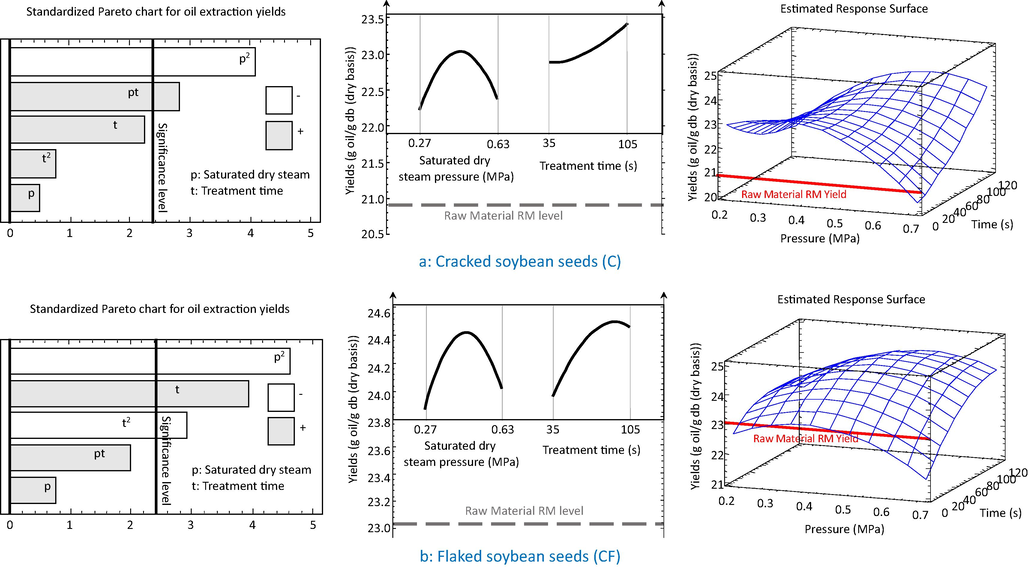
Impact of DIC Parameters on oil yields in cracked C and flaked CF soybean seeds.
Similarly, Eq.6 gives the second-order empirical regression model of the extraction yields Yoil (expressed in g oil/g db) for cracked soybeans, versus the DIC processing parameters; P in MPa and t in s with R2 = 81.72%.
The DIC parameters for cracked and flaked soybeans were optimized at 0.48 MPa for 105 s and 0.49 MPa and 96 s, with oil yields of 0.2452 and 0.24215 g oil/g db, which presents an increase of 0.033 and 0.00664 g oil/g db or about 14.56% and 3% higher than initial C and CF beans, respectively.
Fig. 5 also shows a higher significant effect of the DIC processing parameters on the extraction yield of flaked soybeans CF with a regression coefficient R2 = 89.13 and 0.05 as p-value. Oil availability Yoil,CF was given as an empirical regression model in Eq. (7):
By DIC texturing the flaked soybeans at 0.49 MPa for 96 s, oil yield reached 0.2452 g oil/g db revealing an increase of 0.017 g oil/g db higher than the simply flaked soybeans.
In both cases C and CF, the optimal saturated steam pressure was identical (0.49 MPa). However, the optimal treatment times were different (105 and 96 s, respectively). This is obviously because the DIC treatment time depends on the thickness and the moisture and heating diffusivities.
The study confirms an improvement in extraction yields and kinetic extraction essentially generated by a change in the technological aptitude of the grains treated with DIC.
Based on the results of the statistical study (separate effects Fig. 5), variation in extraction efficiencies as a function of the calculated amount of self-sprayed steam (Eq (1)), and for a pressure variation interval of [0.27, 0.63] confirms a positive correlation represented in Fig. 6 for both the crushed and crushed - flaked soybean study.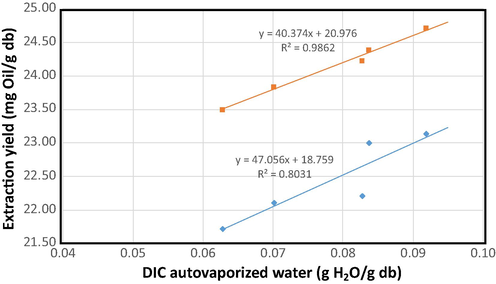
Correlation of the amount of the autovaporized vapor and oil extraction yield.
3.3 Statistical analyses of the impact of DIC on extraction kinetics
To study the impact of various modifications of seed structure through the pretreatment operations (cracking, flaking, and expansion) and DIC texturing technology on the kinetics of oil extraction by n-hexane at each pretreated level of soybean, a study of the extraction yields as a function of time was conducted. The purpose of the dynamic maceration extraction was to compare the TRY (time required to achieve the same yields as cracked C beans) for CF beans those from expander and suitable DIC-textured seeds (under optimal DIC conditions). The experimental results (Fig. 7) show that regardless of the level of pretreatment; Cracked, flaked, or expanded, DIC texturing greatly accelerated the extraction process. Thus, while for cracked soybeans, the oil yield of 0.207 g of oil/g db was reached in 160 min, a DIC-texturing made it possible to obtain this level in only 35 min (TRY = 35 min), meaning three times faster extraction capacity. For flaked soybean seeds, the value of TRY was almost similar to the cracked beans, thus 160 min. The effect of expander was to reduce this TRY time to almost 120 min, which is about 1.33 times faster solvent extraction than for cracked or cracked/flaked beans. It is worth highlighting that the optimized DIC texturing is about 4.7 times faster for solvent extraction (TRY = 35 min) (Table 2).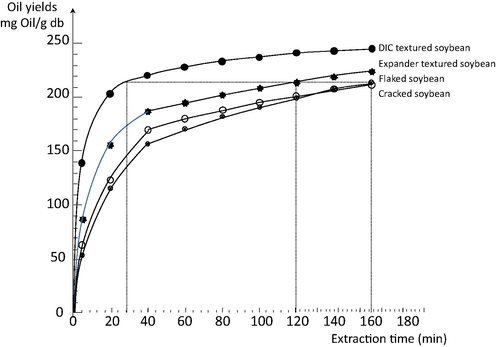
Impact of Instant Controlled Pressure-Drop DIC texturing on oil extraction kinetics of different pretreated soybeans.
Type of pretreatment of soybeans
Deff
δYs
TRY
R2 of CWD model (%)
Value (10−12 m2/s)
Value (mg oil/g db)
Value (min)
Cracked soybeans
3.2 (100%)
124.2 (100%)
160 (100%)
86.57%
Flaked soybeans
1.7 (53%)
148.7 (120%)
160 (100%)
95.55%
Expander textured by flaked soybeans
2.7 (84%)
166.3 (134%)
120 (75%)
98.64%
DIC textured flaked soybeans
6.5 (203%)
199.6 (161%)
37 (22%)
98.84%
Based on preliminary results and data issued from literature, the operations of the kinetics were considered for 160 min the differently treated seeds. In the cases of solvent extraction process of soybean, the highly stirred dynamic maceration was defined as a NER Negligible External Resistance process, which means that the resistance of the solute oil-in-solvent transport compared to the internal diffusion transfer was so weak that the properly said unit operation was methodically controlled by the internal mass transfer. We thus reviewed these different cases of kinetics through the Coupled Washing Diffusion CWD phenomenological model. With beans assumed to be spherical form, the slope K (s−1) issued from Eq (4) was used to identify the effective diffusivity Deff (m2/s). Fig. 7 shows its evolution versus the different processing parameters of DIC.
From the diffusion theoretical curve, the starting accessibility was estimated as the yield of extracted oil before the diffusion process became the limiting phenomenon. It is projected by subtracting the inferred theoretical diffusion value Y0 and the experimental value Yi at t = 0 (Eq. (5)). The starting accessibility δYs divulges the oil extracted through a direct interaction between the grain surface and the solvent.
Cracked-flaked CF soybeans normally had lower effective diffusivity (Deff = 1.7 against 3.2 10−12 m2/s), and higher starting accessibility δYs (0.1487 against 0.1242 g oil/g db) than only cracked C seeds. Certainly because of the decrease in porosity and an increase in exchange surface that flaking normally fetches.
Oppositely, by creating much higher porosity than expansion did, DIC-texturing resulted in twice more effective diffusivity while the starting accessibility was 60% higher (Fig. 7 and Table 2). These experimental data demonstrate that DIC texturing is a crucial pretreatment, which marks much better than expander, the higher diffusivity and apparent exchange surface.
Specifically, the experiments confirmed what was predicted from the fundamental instantaneous thermodynamic analyses. Thus, although similar in terms of saturated steam pressure and process temperature, the DIC texturing resulted in a greater intensification of the solvent extraction. The greater the structure modification, the higher the porosity and tortuosity, and thus, the better the technological capabilities of DIC textured soybeans. This was confirmed by scanning electron microscopic (SEM) observations in (Fig. 8) to better recognize the biological microstructure and textural modifications in each pretreated group of seeds.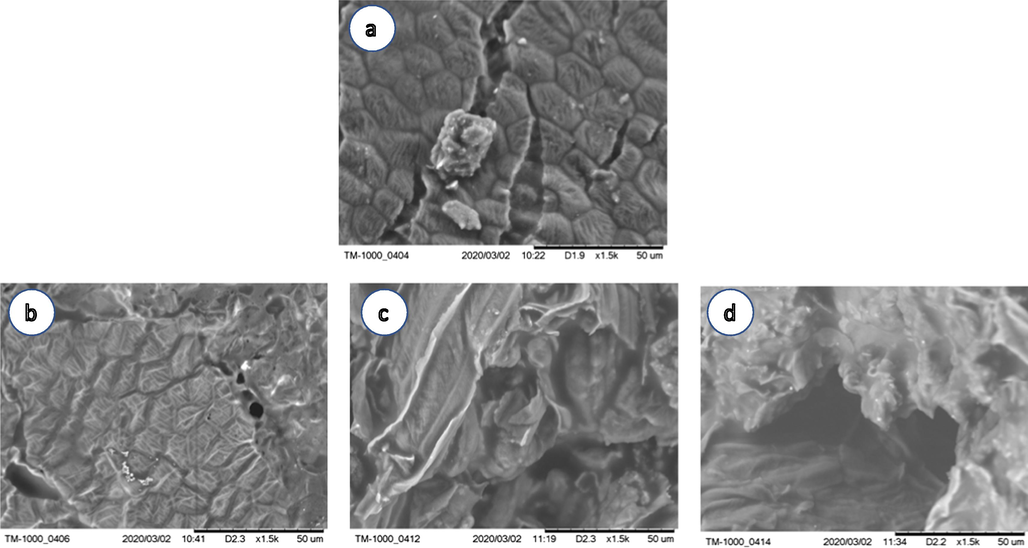
Impact of expander and Instant Controlled Pressure-Drop DIC texturing on structure of Crushed - flaked soybeans by scanning electron microscopic SEM observation: (a) non thermal textured seeds; (b) Expander treated seeds; (c) DIC textured seeds; (d) DIC-textured of Expander treated seeds.
The microstructure of Crushed - flaked soybeans presents effectively organized cells, while expander thermal texturing implies slight modifications of these cells. The impact of DIC was much more important in opening the cells and, thus, increasing the oil kinetic extraction. The most expansion impact became from coupling both expander and DIC treatments.
Moreover, depending on the severity of each operation, possible broken-wall cells may occur. However, the DIC stands out by reaching a more expanded structure, getting, just after decompression, lesser equilibrium temperature (usually 33 °C instead of 100 °C) that is to say no further cooling stage is needed and requiring much lower energy consumption. DIC allows increasing oil yields, quality preservation, and effective kinetics.
3.4 Gas chromatography analyses and soybean oil quality versus DIC treatment conditions
Gas chromatography was used to identify and quantify the fatty acid compounds of the different oil samples. Table 3 presents the two groups of saturated and unsaturated lipids. The amounts of the palmitic acid (C16:0), stearic acid (C18:0), and arachidic acid (C20:0), which are the saturated fatty acids, were preserved after DIC treatment at their initial percentages of 11%, 4.5%, and 0.4%, respectively. The same behavior was observed for the unsaturated fatty acids with oleic acid (C18:1), linoleic acid (C18:2), and linoleic (C18:3) whose percentages were 24.1%, 53%, and 7%, respectively. In optimized DIC texturing conditions, the yield enhancement was accompanied by substantial preservation of the oil quality.
Fatty acids
Cracked bean oil
Flaked bean oil
Expander-bean oil
Treatments
RM
DIC OPT
RM
DIC OPT
RM
C16:0
10.96 ± 0.61
11.02 ± 0.58
11.01 ± 0.72
10.87 ± 0.48
10.83 ± 0.51
C18:0
4.55 ± 0.02
4.5 ± 0.02
4.51 ± 0.01
4.53 ± 0.02
4.46 ± 0.01
C18:1
24.13 ± 1.31
24.04 ± 1.62
23.81 ± 1.57
24.76 ± 2.01
24.02 ± 1.42
C18:2
52.99 ± 2.55
52.85 ± 3.01
53.11 ± 3.12
52.37 ± 2.88
53.1 ± 3.15
C18:3
6.95 ± 0.04
7.07 ± 0.05
7.12 ± 0.03
7.1 ± 0.05
7.19 ± 0.06
C22:0
0.42 ± 0.01
0.52 ± 0.01
0.44 ± 0.01
0.39 ± 0.01
0.41 ± 0.01
Delta (µg/g oil)
191.39 ± 9.52
177.82 ± 8.02
175.90 ± 10.85
208.95 ± 11.30
162.55 ± 8.95
Gama (µg/g oil)
341.21 ± 10.20
378.08 ± 11.33
327.00 ± 10.01
284.99 ± 09.84
308.78 ± 11.32
Alpha (µg/g oil)
48.38 ± 1.51
46.84 ± 1.32
36.28 ± 2.01
34.58 ± 1.85
40.14 ± 2.10
Total Tocopherols (µg/g oil)
580.98 ± 14.32
602.74 ± 15.12
539.18 ± 13.83
528.52 ± 14.12
511.47 ± 15.03
Such a similarity in the lipid profiles of oil extracted from raw material (RM) and DIC-textured soybeans allowed increasing yields, enhancing the kinetics, and preserving the oil and cake quality.
Moreover, the data (Table 3) based on a comparative determination of the tocopherols content (δ, γ, and α), show a slightly-significant variation according to the differently DIC treated soybeans. These modifications inside the values of tocopherol compounds; δ, γ, and α occurred but without any negative impact on total tocopherol content. Moreover, as usual, optimized DIC treatment allows preserving or even increasing the antioxidant availability in various types of plant-based materials, because of the new porous texture performed at high temperature for a very short time (High-Temperature/Short-Time HTST DIC process). The fact that Expander treatment implies much larger thermal treatment time and resulting in much lower porosity than DIC perfectly explains this behavior.
As confirmed in the work of (Mannaï et al., 2019) and (Jablaoui et al., 2018), a high-temperature/short-time treatment, a suitably optimized DIC involves significant conservation of the biochemical composition, even for thermal sensitive molecules. Indeed, since the high-temperature treatment is achieved in a very short time and the final low temperature is immediately reached thanks to the vacuum level, DIC treatment didn’t imply any notable biochemical degradation.
3.5 Industrial application: Energy balance and environmental impact
The integration of DIC in the industrial process of solvent extraction of soybean oil results in a great reduction of the operation time and an overall increase in oil yield with preservation of the quality. Thus, for a total quantity of one ton (1000 kg) of raw material, the oil yields become 177 kg for DIC-soybeans in about 35 min and 163 kg for expander-soybeans in about 120 min against 154 kg in 160 min for nonthermal textured cracked soybeans (Table 4).
Pre-thermal texturing data
mo/md
md
mo
mw
Ta
Tt
Tf
Tc
ΔTpd
Qh
Qc
Qt
mv
Energy Cost/Added kg oil (kWh kg−1 oil)
(kg)
(°C)
(kWh)
(kg)
Non-textured
0.210
735.78
154.22
110
/
/
/
/
/
/
/
/
Expander
0.224
727.89
163.11
110
20
159
100
33
59
62
30
92
46
10.35
DIC
0.249
712.60
177.40
110
20
152
33
33
119
60
0
60
92
2.57
The “Expander” and DIC operations need energy consumptions, which can be issued from Eq. (1). They both depend on the treatment temperatures and oil and water contents:
This table allows justifying the interest of using DIC texturing as an intensification way of solvent extraction of soybean oil. The environmental impact is directly correlated with energy consumption.
4 Conclusion
It is well known that the natural structure of plant organs (fruit, vegetables, leaves, roots, seeds…) has a too weak technological aptitude versus numerous unit operations of extraction. Adequate pretreatments of the natural structure may, if well-defined, lead to increasing the yields and enhancing the operation kinetics while preserving the final oil and cake quality. Hence, in this way for the specific case of solvent extraction of soybean oil, a new trend was introduced at the industrial scale; this has been the pretreatment through the texturing of cracked and/or cracked/flaked beans. Another texturing process was also separately studied; the Instant Controlled Pressure-Drop DIC. The current research aimed to mainly compare the impact of these both texturing operations of expander and DIC before the n-hexane solvent extraction resulted in so greater kinetics. The “expander” allowed the oil yield of cracked soybean to increase from 209.6 in 160 min to 224.4 mg oil/g db in 120 min, while DIC texturing resulted in a yield of up to 248.95 mg oil/ g db in about 35 min.
The phenomenological modeling of coupled washing diffusion CWD allowed defining and measuring the effective solvent diffusivity Deff as well as the starting accessibility δYs of N-hexane solvent extraction of soybean oil in the different studied cases. Deff and δYs were recognized as 0.022 10−10 m2/s and 124.2 mg oil/g db, respectively for the non-textured cracked beans. After the expander treatment, they increased until 0.027 10−10 m2/s and 166.3 mg oil/g db, respectively. The specific texturing by DIC resulted in much higher Deff and δYs with 0.065 10−10 m2/s and 199.6 mg oil/g db, respectively.
GC and HPLC assessments of the oil established that the fatty acid profiles and tocopherol contents for the DIC-textured soybeans were almost similar to the untextured seeds. This reveals that optimized DIC texturing is correlated with the absence of any significant biochemical degradation. Indeed, although DIC texturing implies the use of high-temperature saturated steam, it is performed in so specific short time that it results in the preservation of the oil quality in terms of fatty acids’ compounds and tocopherol content. This study proves the ability of DIC treatment to preserve the extracted oil quality.
The present technical and scientific study as well as the first approach of the economic analysis shows that DIC can advantageously replace the mechanical flaking and thermal texturing Expander. The well-optimized DIC allows reducing the extraction time, increasing yield, and preserving the quality of finished oil and cake products with low energy consumption and positive environmental impact.
Acknowledgments
The authors would like to thank both La Rochelle University and Carthage Grains who financially supported this research work. Thanks also to ABCAR-DIC Process who provided the laboratory-scale and industrial-scale DIC units.
Declaration of Competing Interest
The authors declare that they have no known competing financial interests or personal relationships that could have appeared to influence the work reported in this paper.
References
- Allaf T., Allaf K., eds. Instant Controlled Pressure Drop (D.I.C.) in Food Processing: From Fundamental to Industrial Applications, Food Engineering Series. New York: Springer-Verlag; 2014.
- DIC texturing for solvent extraction. In: Allaf T., Allaf K., eds. Instant Controlled Pressure Drop (D.I.C.) in Food Processing: From Fundamental to Industrial Applications, Food Engineering Series. New York, New York, NY: Springer; 2014. p. :127-149.
- [CrossRef] [Google Scholar]
- Impact of texturing using instant pressure drop treatment prior to solvent extraction of anthocyanins from Malaysian Roselle (Hibiscus sabdariffa) Food Chem.. 2009;115:820-825.
- [CrossRef] [Google Scholar]
- Green extraction procedures of lipids from Tunisian date palm seeds. Ind. Crops Prod.. 2017;108:520-525.
- [CrossRef] [Google Scholar]
- Phenomenological modeling and intensification of texturing/grinding-assisted solvent oil extraction: case of date seeds (Phoenix dactylifera L.) Arab. J. Chem.. 2019;12:2398-2410.
- [CrossRef] [Google Scholar]
- Tocopherols in soybean seeds: genetic variation and environmental effects in field-grown crops. J. Am. Oil Chem. Soc.. 2008;85:931-936.
- [CrossRef] [Google Scholar]
- Quality of the 2004 Soybean Crop from the United States. White Pap: Agric. Biosyst. Eng. Tech. Rep; 2004.
- Review of green food processing techniques. Preservation, transformation, and extraction. Innov. Food Sci. Emerg. Technol.. 2017;41:357-377.
- [CrossRef] [Google Scholar]
- Environmental impact assessment of soybean oil production: Extruding-expelling process, hexane extraction and aqueous extraction. Food Bioprod. Process.. 2018;108:58-68.
- [CrossRef] [Google Scholar]
- de Carvalho Claudio Guilherme Portela, da Silva Matheus Felipe, Mandarino José Marcos Gontijo, Grunvald Anna Karolina, Ramos Nilza Patrícia, Ribeiro José Lopes, de Paulo Campos Godinho Vicente, 2018. Fatty Acid Profiles in Sunflower Grains During Storage in Different Environments. J. Am. Oil Chem. Soc. 95, 61–67. https://doi.org/10.1002/aocs.12007
- Kinetic study of canola oil and tocopherol extraction: Parameter comparison of nonlinear models. J. Food Eng.. 2012;111:682-689.
- [CrossRef] [Google Scholar]
- Hammond, E.G., Johnson, L.A., Su, C., Wang, T., White, P.J., 2005. Soybean Oil, in: Bailey’s Industrial Oil and Fat Products. American Cancer Society. https://doi.org/10.1002/047167849X.bio041
- Hernandez, E., 2019. Production, Processing, and Refining of Oils. In Healthful lipids/Editors, Casimir C. Akoh and Oi-Ming Lai. Taylor & Francis Group ISBN 13: 978-1-893997-51-6 (hbk).ISO 659:1998 - Oilseeds -- Determination of oil content (Reference method) [WWW Document], n.d. URL https://www.iso.org/standard/23297.html (accessed 4.5.18).
- Jablaoui, C., 2018. La texturation par detente instantannée [sic] controlée DIC dans le developpements [sic] de nouvelles opérations d’extraction d’huiles des graines oleagineuses (phdthesis). Université de La Rochelle ; Université de Carthage (Tunisie).
- Jablaoui, C., Besombes, C., Jamoussi, B., Ismail, H.B., Rhazi, L., Allaf, K., 2018. Phytosanitary Decontamination of Crude Rapeseed Oil by Instant Multi-Flash Autovaporization (MFA) 3, 13.
- Instant controlled pressure drop as new intensification ways for vegetal oil extraction. In: Chemat F., Vorobiev E., eds. Green Food Processing Techniques. Academic Press; 2019. p. :221-244.
- [CrossRef] [Google Scholar]
- Comparison of alternative solvents for oils extraction. J. Am. Oil Chem. Soc.. 1983;60:229-242.
- [CrossRef] [Google Scholar]
- Enhancing Extraction Processes in the Food Industry. CRC Press; 2016.
- DIC as a pretreatment prior to ultrasonic extraction for the improvement of rebaudioside A yield and preservation of vitamin B1 and B6. J. Food Meas. Charact.. 2019;13:2764-2772.
- [CrossRef] [Google Scholar]
- Mark Ash and Dana Golden, July 2020. Oil Crops Outlook. USDA (United States Department of Agriculture) No. (OCS-20g) 7 pp.
- Aqueous enzyme assisted oil extraction from oilseeds and emulsion de-emulsifying methods: A review. Trends Food Sci. Technol.. 2015;41:60-82.
- [CrossRef] [Google Scholar]
- Temperature-dependent diffusion coefficient of oil from different sunflower seeds during extraction with hexane. J. Food Eng.. 2011;105:180-185.
- [CrossRef] [Google Scholar]
- Aqueous and enzymatic processes for edible oil extraction. Enzyme Microb. Technol.. 1996;19:402-420.
- [CrossRef] [Google Scholar]
- Effects of expander process on the phospholipids in soybean oil. J. Am. Oil Chem. Soc.. 1994;71:1145-1148.
- [CrossRef] [Google Scholar]







